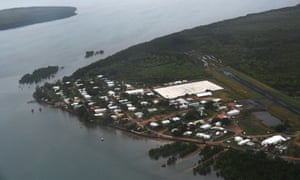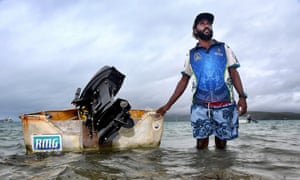Extract from The Guardian
Torres Strait residents face being forced from their homes by climate change, as their islands are lost to rising seas.
On Boigu Island, the most northerly inhabited island in Australia, just six kilometres from Papua New Guinea, the community’s cemetery faces inundation and roads are being washed into the sea. A seawall installed to protect the community is already failing.
Boigu elder Dennis Gibuma says the situation is worsening every season.
“Our seawall is no longer any good,” he says. “When the high tide and strong winds come together, it breaks. We pray we don’t lose our homes. We don’t want to leave this place.”
Masig Island, to the south-east of Boigu, is less than three kilometres long, and just 800m across at its widest point. Also known as Yorke Island, the low-lying coral cay is steadily being lost to the waves.
“The island is being eaten,” says Songhi Billy, an engineering officer on Masig. “This is a big issue. I kind of feel hopeless in a sense. Our land is part of us.
“In the short term, we can do what we can. We can’t stop the erosion, our hope is to slow it down.”
But he says he has to face the possibility that his people may have to abandon their ancestral home.
“Long term, we may have to evacuate the island,” he says. “But I am not going. Slowly, I see Masig Island getting out of something I can control.”
Fisherman Joseph Billy says his community is losing land every year.
“Last five year, every year, I have moved my shed back from the beach another few metres. We used to have a road that went all around the island but now it is broken. We will lose our land eventually.”
Sea levels around the world are expected to rise between 75cm and 1.5m by the end of the century, depending on greenhouse gas emissions. According to the Australian Department of Environment and Energy, a rise of just 50cm would increase the risk of flooding around Australia by 300 times – making a once a century flood likely to occur several times a year. In some areas of Australia, flooding risk would rise much more – up to 10,000 times.
The precise sea level rise around the Torres Strait, and the projected inundation, has not been calculated but low-lying islands are expected to experience a much greater flooding risk than mainland Australia. The department identifies the remote islands of the Torres Strait as some of the most vulnerable, as does the Intergovernmental Panel on Climate Change (IPCC), which warns communities they may be forced to relocate.

On Boigu Island, the most northerly inhabited island in Australia, just six kilometres from Papua New Guinea, the community’s cemetery faces inundation and roads are being washed into the sea. A seawall installed to protect the community is already failing.
Boigu elder Dennis Gibuma says the situation is worsening every season.
“Our seawall is no longer any good,” he says. “When the high tide and strong winds come together, it breaks. We pray we don’t lose our homes. We don’t want to leave this place.”
Masig Island, to the south-east of Boigu, is less than three kilometres long, and just 800m across at its widest point. Also known as Yorke Island, the low-lying coral cay is steadily being lost to the waves.
“The island is being eaten,” says Songhi Billy, an engineering officer on Masig. “This is a big issue. I kind of feel hopeless in a sense. Our land is part of us.
“In the short term, we can do what we can. We can’t stop the erosion, our hope is to slow it down.”
But he says he has to face the possibility that his people may have to abandon their ancestral home.
“Long term, we may have to evacuate the island,” he says. “But I am not going. Slowly, I see Masig Island getting out of something I can control.”
Fisherman Joseph Billy says his community is losing land every year.
“Last five year, every year, I have moved my shed back from the beach another few metres. We used to have a road that went all around the island but now it is broken. We will lose our land eventually.”
Sea levels around the world are expected to rise between 75cm and 1.5m by the end of the century, depending on greenhouse gas emissions. According to the Australian Department of Environment and Energy, a rise of just 50cm would increase the risk of flooding around Australia by 300 times – making a once a century flood likely to occur several times a year. In some areas of Australia, flooding risk would rise much more – up to 10,000 times.
The precise sea level rise around the Torres Strait, and the projected inundation, has not been calculated but low-lying islands are expected to experience a much greater flooding risk than mainland Australia. The department identifies the remote islands of the Torres Strait as some of the most vulnerable, as does the Intergovernmental Panel on Climate Change (IPCC), which warns communities they may be forced to relocate.

The chief executive of Oxfam Australia, Helen Szoke, who visited the Torres Strait at the invitation of the Torres council mayor, Vonda Malone, says the people of the strait have contributed almost nothing to the causes of climate change but are being “hit first and hardest by its impacts”.
“The islands face a combination of risks including coastal erosion and inundation from rising seas, damage to the critical marine ecosystems on which their livelihoods depend, higher temperatures and shifting rainfall. Roads are being washed away and seawalls cannot protect communities from flooding.”
The “strong, flourishing communities” of the Torres Strait have a powerful connection to their land and sea country, Szoke says.
“The gravest fear among community members is the loss of their connection to land and culture if they are faced with the last resort – being forced to leave their islands. The longer-term challenges, including the threat of eventually being forced from their land, are complex and extremely confronting for communities with such a deep connection to their islands.”
Malone says leaving the islands is a last resort and the people of the Torres Strait want to do everything possible to remain.
“These communities are facing ongoing challenges in retaining their foreshore and their gathering places – this is their land and the land of their ancestors. These communities are seeing their land washed away. We have been advocating for years but it just does not seem to get enough attention.”
Malone says while some funding for climate change adaptation is filtering through, there were few resources to address the social impacts of potential dislocation.
“There is a feeling of hopelessness as communities do not know where this is going to lead to,” Malone says.
Displacement caused by climate change is forecast to be a driver of massive forced migration movements in the 21st century.
Low-lying islands in the Pacific – and Torres Strait islands like Masig and Boigu – are likely to be at the forefront of forced displacement but large and densely populated countries such as Bangladesh also face widespread inundation.
Some forecasts have predicted up to 150 million people could be forcibly displaced by climate change by 2040 – larger than the record number of people already forced from their homes globally.
The US and other militaries have said that climate change poses the greatest security threat to the Asia-Pacific.
But the global legal framework for resettling people displaced from their homes lost to natural disasters or climate change is unclear. The refugee convention – established in 1951 to regularise the resettlement of those displaced by the second world war – does not recognise someone forced from their home by rising seas, or natural disaster, as requiring protection.
Already, more than a dozen Pacific Islanders have attempted to claim refugee status in New Zealand on the grounds that their homes are uninhabitable because of rising seas or climate-related disaster. All have had their claims rejected.
On Masig Island, Hilda Mosby says climate change is already affecting the marine ecosystems on which communities depend for their livelihoods. Climate change is already affecting her community “big time”, she says.
But the greater existential threat for her home lies ahead.
“When we talk about relocation, it is clear this is very much a last resort,” Mosby says. “This is our home. No one is willing to leave, to lose their cultural ties, the loved ones they have laid to rest here. We want to try everything to keep our community here.”

No comments:
Post a Comment